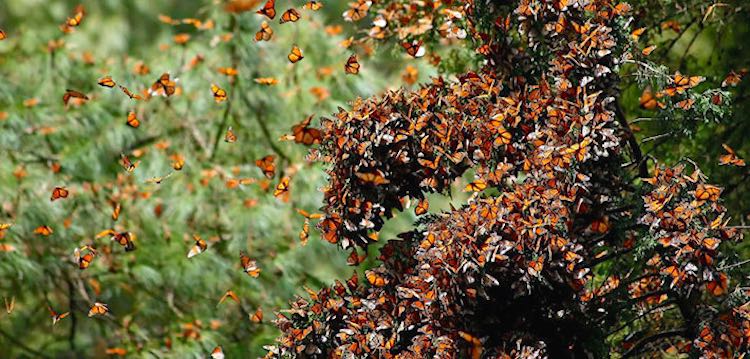Try to imagine 10 acres of woodland fields and branches dripping with butterflies. That’s what the remarkable comeback of the monarch species looked like this winter following the annual migration.
Three-and-a-half times as many monarchs as the year before returned to their home in the central Mexico mountains this winter.
Each year, the black and orange insects migrate 3,400 miles south to the tropical climate. Their numbers had been falling in recent years, until a resurgence in 2014. This year’s increase has been even greater.
WANT MORE ANIMAL GOOD NEWS? … GET OUR APP—> Download FREE for Android and iOS
It’s impossible to actually count all the individual butterflies, but because they huddle so closely together, scientists and conservationists add up all the land area the monarchs cover. This winter it came to 10 acres of butterflies — up from a record low of 1.66 acres just two years earlier.
It’s a strong recovery, but still has a long way to go to match the 44 acres of butterflies from 1996.
Mexico, the U.S., and Canada have all committed to helping the monarchs recover. The U.S. is reintroducing milkweed plants along 1,100 square-miles of the monarchs’ migration route to make up for herbicide use destroying huge tracts of the plant. Monarchs lay their eggs on milkweed exclusively, and find it a vital food source.
CHECK OUT: Husband Plants Field of Flowers for Blind Wife to Smell–So Spectacular it Gets Visitors
Mexico successfully cracked down on illegal logging in the monarch reserve, where the butterflies rely on the forest canopy to help shelter them during winter.
Conservationists estimate 140 million monarchs arrived this year, and if the upward trend continues they will hit their goal of seeing 220 million by 2020.
“It is time for celebration because we see the beginning of success,” U.S. Fish and Wildlife Service Director Ashe told the Associated Press. “But our task now is to continue building on that success.”
(Photo by Pablo Leautaud, CC)
Share the Good News, People May Need it…




















